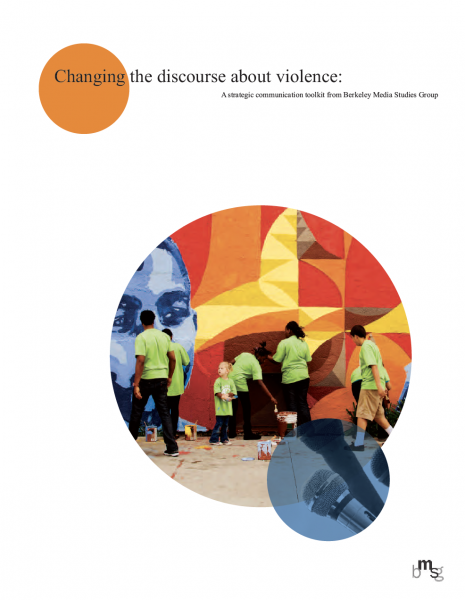
Update
Improving Media Coverage of Violence: What Journalists Want Advocates to Know
-
Focus Areas
Capacity Building & Leadership -
Issues
Violence Prevention -
Programs
Berkeley Media Studies Group

If we want to prevent violence, policymakers and the public at large must understand its root causes and the social context in which it occurs. After all, we can’t address a problem if we don’t entirely understand it.
Yet, as research conducted by Berkeley Media Studies Group has shown, news coverage of violence provides a distorted view of the issue. It tends to focus more on individual acts than on the many social factors that lead to violence. It also overreports rare tragedies and extreme events like mass shootings while underreporting more common types of violence, like suicide, domestic violence, and street-level violence.
 |
What’s more, shrinking newsroom budgets and tight deadlines in today’s always-on media environment make it increasingly challenging for journalists to tell broader stories about violence that include social factors such as poverty, disinvestment, or trauma.
That’s why advocates must build relationships with reporters and help them include more of the social context for violence in their stories. What, then, can advocates do to become trusted sources and, ultimately, bring prevention to the fore? As it turns out, a lot.
A new BMSG toolkit, “Changing the Discourse About Violence,” can help advocates refine their communication strategies and leverage the power of the media to reframe violence. Additionally, BMSG sat down with several experienced journalists to ask what it would it take to bring public health and social justice perspectives into their coverage of violence.
Here are five lessons that we learned:
Know how to deliver an effective story pitch
The reporters we spoke to told us that an effective pitch can make all the difference between whether or not a story gets coverage. “If you see a well-written press release or a well-written email, I’m much more likely to pick up on that story, especially if that email mentions sources I can interview,” said Mercury News reporter Tammerlin Drummond.
An effective pitch should be concise — no more than a few paragraphs in an email — and it should answer a few basic questions, such as: “What’s the story?” and “Who can be interviewed for it?”
But getting a journalist excited about your story idea is not a guarantee that it will make the news the next day. It also depends on whether the journalist is able to successfully pitch the story to their editor. With this in mind, advocates should consider what makes their story newsworthy. Drummond noted that, as a reporter, she has to consider whether her editor will say, “This is a snooze fest.”
Drummond advised advocates that when pitching stories to a reporter, they should be prepared to answer the question, “Why cover this story now?” If you can successfully make the case that your issue is timely and connected to current events, you’ll increase the chances that your story gets selected for the news.
Use email wisely
For the majority of journalists (92 percent, according to one study), email is the preferred means of receiving a pitch from a source. Your email should be short, respectful, and to the point. It also needs to be directed to the right person.
Knowing who to pitch your story to requires an understanding of the media landscape. San Francisco Chronicle reporter Kevin Fagan told us that advocates “have to know who the key person [is] covering a particular issue.” Read your local newspaper and listen to or watch your local TV or radio news to see who’s covering violence and related community issues. Pay attention to what angles particular journalists take with their stories. What do they tend to prioritize? When you find a journalist whose perspective aligns with the story you are trying to tell — or if you see the potential for alignment — that’s a good person to pitch your story to.
Rather than trying to pitch your story to the editor of a particular section of the news, Fagan recommended going directly to the journalist covering that beat. “Editors are bombarded,” Fagan said.
Know what resources reporters want
When pitching stories to journalists, advocates should “have their package together,” Drummond said. Journalists want advocates to know they operate on tight timelines — they may have as little as three to four hours to pull together a story. By providing them with the key resources they need, the odds of your pitch being successful will be higher.
While there are no standard requirements for what such a “package” should contain, here are some ideas for resources you may wish to have at your fingertips:
- If your organization plans to hold a news conference or other press event, make sure you have a media advisory and a news release ready to circulate in advance. A media advisory is a brief alert to journalists of an upcoming press event; it informs them of the time, date, location, and other logistics and provides a brief summary of the event. A news release provides more detailed information for reporters and may include quotes from spokespeople, context about the story, data, and other pertinent information. A news release should read like the ideal article you would like to see in the news (it’s not uncommon for sections of news releases to appear virtually intact in print and broadcasts). BMSG has resources and templates to help you construct news releases and media advisories.
- If your organization has recently released a report on violence and how it impacts your community, share it with journalists. A newly released report is newsworthy, particularly when it can be tied to current local or national events, which can serve as a secondary newsworthy element.
- If your organization has relevant data to share, develop a one-page fact sheet and attach it to your pitch in an email. This will help you establish credibility and give the reporter a key ingredient they need to tell their story.
- If you have community or expert spokespeople who the journalist could interview, be sure to include their names and contact information as well (be sure to check with them first!).
Think like a reporter
We heard consistently from journalists that the media landscape is vastly different than it was just 10 years ago. In the digital age, stories are continually updated throughout the day, and reporters need to compose or refresh their stories fast. Reporters turn to sources who can promptly provide them with the information they need.
Lori Udesky, an experienced health journalist, emphasized the importance of providing reporters with data: “I think data is particularly important. Whenever I get any pitch, I want to know where the data is; I want to be able to ensure that the data is accurate.”
Fagan emphasized that having spokespeople readily available is key. “When you need sources, you need them fast,” he said.
As reporters work to keep on top of fast-paced news cycles, putting yourself in their shoes can help serve your goals as well as theirs.
Get creative
The demands of the news industry present both challenges and opportunities when it comes to telling stories about violence from a public health perspective.
One challenge to telling broader stories that incorporate social context is that in the immediate aftermath of a violent event, coverage may be entirely consumed by the “Five Ws” of the incident: Who, what, when, where, and why.
“It’s tough to get context in, especially on deadline,” Fagan said. “The most you’ll get is one paragraph of context.” While breaking news headlines might leave out context, there may be opportunities to introduce public health perspectives in follow-up stories. The journalists we spoke to provided a number of helpful suggestions:
- Use maps: Udesky urged advocates to think visually when pitching stories. Maps, graphs, “pictocharts,” or other creative data visualization tools can help make a public health perspective come alive.
- Dig beneath the surface: Udesky pointed out that the demonization of individuals who commit violence acts as a barrier to bringing a public health perspective to the issue. When perpetrators are portrayed as monsters, the issue of violence becomes individualized. By bringing to light factors in perpetrators’ lives and communities that may predispose them to violence, advocates can help create a prevention frame.
- Pitch a follow-up story: Communities of color that experience violence on a regular basis are often the least likely to be featured in the news. Drummond pointed out that “grinding violence is not well enough covered or understood. Most coverage is focused on individual acts of violence.” Drummond suggested pitching stories that examine the long-term impacts of community violence six-months or a year after a major violent incident. What long-term effects has the community experienced? What has the community done to bounce back?
- Consider alternative outlets: Drummond mentioned several alternative — and often overlooked — media outlets that advocates can pitch their stories to. In addition to print publications, some of which have special sections to feature viewpoints from community members, there are blogs, podcasts, and other forums that advocates may want to consider. For example, outlets such as The Movement from Mic Network Inc. and Reveal News from the Center for Investigative Journalism are specifically designed for long-form articles and may be ideal for exploring issues of violence in greater depth.
While the conventions of the news industry mean that some media coverage will inevitably focus on the details of individual incidents of violence, opportunities for telling broader stories about the social context for violence and how to prevent it still exist. By having the resources journalists rely on readily available, thinking like a journalist, and pitching newsworthy stories with a concise email, we can transform the way we all think about and work to prevent violence in our communities.
Learn more in our new toolkit: “Changing the Discourse About Violence.”
Have you or your organization succeeded in getting a public health perspective on violence included in news coverage? We want to hear about it! Let us know at info@bmsg.org, @BMSG, or on Facebook.
Originally published by Originally posted on BMSG's blog
More Updates
Work With Us
You change the world. We do the rest. Explore fiscal sponsorship at PHI.
Support Us
Together, we can accelerate our response to public health’s most critical issues.
Find Employment
Begin your career at the Public Health Institute.



